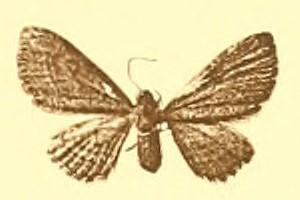Eupithecia nigrilinea is a moth in the family Geometridae. It is found in Afghanistan, Uzbekistan, Kyrgyzstan, Tajikistan, Pakistan, Jammu and Kashmir, Nepal and northern Thailand. The habitat consists of mountainous areas at altitudes ranging from 1,700 to 4,500 meters.
Eupithecia costipicta is a moth in the family Geometridae. It is found in Afghanistan, India (Sikkim) and China. The habitat consists of mountainous areas at altitudes between 2,300 and 3,500 meters.

Eupithecia barteli is a moth in the family Geometridae. It is found in Afghanistan, the southeastern part of European Russia, north-western Kazakhstan, Tajikistan, Nepal, India and China.

Eupithecia minusculata is a moth in the family Geometridae. It is a widespread species, ranging from Spain through North Africa and the Middle East to Mongolia. In the north, the range extends to the lower part of the River Volga. In Central Asia, it is found in Turkmenistan, Uzbekistan, Tajikistan, Afghanistan, southern Kazakhstan, and north-western China (Xinjiang). The habitat consists of deserts or xerophilous areas.
Eupithecia conjunctiva is a moth in the family Geometridae. The moth is found in Afghanistan, northern Pakistan, Jammu and Kashmir and northern India, and Nepal. It is found at altitudes between 1,100 and 3,000 meters.
Eupithecia karnaliensis is a moth in the family Geometridae. It is found in Afghanistan, the Great Western Himalaya Mountains and Nepal. It is found at altitudes between 2,200 and 3,200 meters.
Eupithecia tabestana is a moth in the family Geometridae. It is found in eastern Afghanistan, northern Pakistan and central Nepal.
Eupithecia obtinens is a moth in the family Geometridae. It is found in Afghanistan and Iran.
Eupithecia fredi is a moth in the family Geometridae. It is found in eastern Afghanistan.
Eupithecia nepalata is a moth in the family Geometridae. It is found in Afghanistan, Tajikistan, northern Pakistan, northern India and Nepal. The habitat consists of mountainous areas.
Eupithecia infecunda is a moth in the family Geometridae. It is found in Afghanistan and western Pakistan.
Eupithecia parallelaria is a moth in the family Geometridae. It is found in Turkmenistan, Iran, eastern Afghanistan and Kashmir.
Eupithecia mitigata is a moth in the family Geometridae. It is found in Afghanistan, Tajikistan, Kyrgyzstan, southern Kazakhstan, north-western China (Xinjiang) and Kashmir.
Eupithecia lindti is a moth in the family Geometridae. It is found in Afghanistan, the mountains of Uzbekistan, Tajikistan, and northern Pakistan and India.
Eupithecia xanthomixta is a moth in the family Geometridae. It is found in Afghanistan and Iran.
Eupithecia repetita is a moth in the family Geometridae. It is found in Afghanistan and western Pakistan.
Eupithecia egregiata is a moth in the family Geometridae. It is found in Afghanistan and Pakistan.
Eupithecia exactata is a moth in the family Geometridae. It is found in Afghanistan, northern Iran, Kyrgyzstan, Tajikistan, Jammu & Kashmir, south-eastern Kazakhstan, north-western China (Xinjiang) and Mongolia. The habitat consists of mountainous areas.
Eupithecia marginata is a moth in the family Geometridae. It is found from Cyprus through the northern Caucasus (Daghestan), Armenia, Azerbaijan, Iran, Afghanistan, Uzbekistan, Tajikistan and Kyrgyzstan to south-eastern Kazakhstan and north-western China (Xinjiang).
Eupithecia exicterata is a moth in the family Geometridae. It is found in Afghanistan and the western Himalayas.
